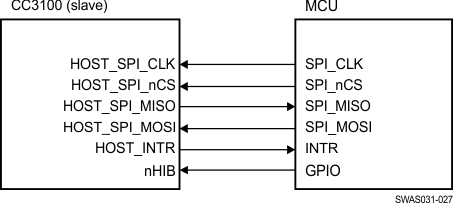JAJSK09B November 2014 – September 2020 CC3100MOD
PRODUCTION DATA
- 1 特長
- 2 アプリケーション
- 3 概要
- 4 機能ブロック図
- 5 機能ブロック図
- 6 Revision History
- 7 Terminal Configuration and Functions
-
8 Specifications
- 8.1 Absolute Maximum Ratings
- 8.2 ESD Ratings
- 8.3 Power-On Hours (POH)
- 8.4 Recommended Operating Conditions
- 8.5 Power Consumption Summary
- 8.6 TX Power and IBAT versus TX Power Level Settings
- 8.7 Brownout and Blackout Conditions
- 8.8 Electrical Characteristics (3.3 V, 25°C)
- 8.9 WLAN RF Characteristics
- 8.10 Reset Requirement
- 8.11 Thermal Resistance Characteristics for MOB Package
- 8.12 Timing and Switching Characteristics
- 8.13 Host UART
- 9 Detailed Description
- 10Applications, Implementation, and Layout
- 11Environmental Requirements and Specifications
- 12Device and Documentation Support
- 13Mechanical, Packaging, and Orderable Information
パッケージ・オプション
デバイスごとのパッケージ図は、PDF版データシートをご参照ください。
メカニカル・データ(パッケージ|ピン)
- MOB|63
サーマルパッド・メカニカル・データ
発注情報
8.12.3.2 SPI Host Interface
The device interfaces to an external host using the SPI. The CC3100 device can interrupt the host using the HOST_INTR line to initiate the data transfer over the interface. The SPI host interface can work up to a speed of 20 MHz.
Figure 8-9 shows the SPI host interface.
 Figure 8-9 SPI Host Interface
Figure 8-9 SPI Host InterfaceTable 8-3 lists the SPI host interface pins.
Table 8-3 SPI Host Interface
| PIN NAME | DESCRIPTION |
|---|---|
| HOST_SPI_CLK | Clock (up to 20 MHz) from MCU host to CC3100 device |
| HOST_SPI_nCS | CS (active low) signal from MCU host to CC3100 device |
| HOST_SPI_MOSI | Data from MCU host to CC3100 device |
| HOST_INTR | Interrupt from CC3100 device to MCU host |
| HOST_SPI_MISO | Data from CC3100 device to MCU host |
| nHIB | Active-low signal that commands the CC3100 device to enter hibernate mode (lowest power state) |